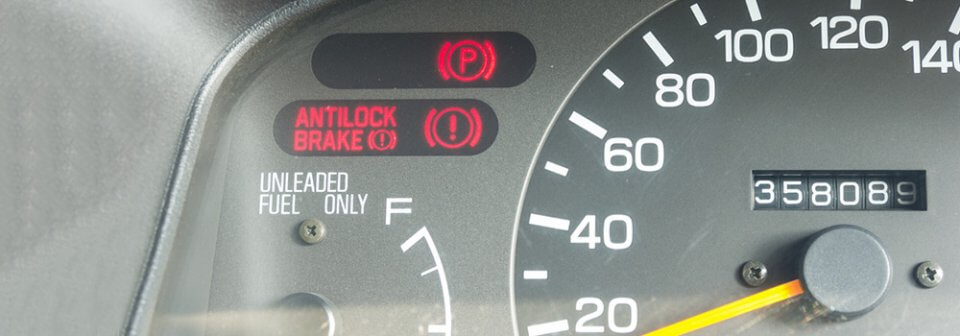
Sudden stops are par for the course when on the road, so any help to drive safely is a welcome feature in your vehicle. That’s precisely what an ABS is for. Learn all you need to know about anti-lock brake systems and how to activate them. If you have one installed, make sure you check into a discount on your auto insurance.
What is ABS?
ABS, or Anti-lock Braking System, is one of the most important safety features an automobile can have. If you suddenly brake, your wheels may lock up, especially on wet and slippery surfaces, which in turn makes you lose traction control of the vehicle. Anti-lock brakes help prevent this, so you don’t skid out of control. In other words, your car maintains directional control around hazards if you can’t make a complete stop in time.
A crucial distinction to make is that ABS helps to maintain control during emergency braking situations ( “panic stops”), but it’s not designed to make you stop faster. It’s true that ABS brakes can shorten stopping distances on certain road conditions, like wet or slippery roads, because it pumps the brakes quicker. However the opposite may happen in the case of soft surfaces like loose gravel, sand or fresh snow.
How do you know if your vehicle has ABS?
Since 2012, the Federal Government has required that all cars must have four-wheel ABS, so modern cars should be covered. If you are have a used model and want to confirm the installation yourself, there are three ways to check:
- When you start your car, check your dashboard and look for the ABS symbol. It should be illuminated once the engine starts.
- Confirm in the owner’s manual.
- Ask your dealer or agency where you made your purchase.
Facts About ABS (Anti-Lock Brake Systems)
- An anti-lock braking system works with the regular brakes on your vehicle.
- Your car will always have its regular braking system, even if ABS were to fail.
- ABS activates only in slippery conditions or during emergency stops when a driver slams on the brakes, causing them to lock up.
- The anti-lock brake system is speed sensitive, and the brake system will not activate at very slow speeds.
- Some systems are designed to prevent only the rear wheels from locking up.
- Rear-wheel-only systems are found on some older pickups and sport utility vehicles.
- Rear wheel ABS keeps your automobile from spinning out of control; however, if the front wheels lock up, you will not have steering control.
- All other ABS systems, including those for cars and minivans, are designed to keep all four wheels from locking up.
- Four-wheel ABS will actually allow you to retain the ability to steer while you’re still braking.
- ABS prevents wheel lockup so that your vehicle stays in a straight line.
- If you have control of your steering wheel, it is possible to avoid a crash by steering around hazards if a complete stop cannot be accomplished in time.
- In cars equipped with ABS, the driver’s foot should remain firmly on the brake pedal, allowing the system to automatically pump the brakes.
- What ABS does is similar to a person pumping the brakes. It automatically changes the pressure in your vehicle’s brake lines to maintain maximum brake performance just short of locking up the wheels.
Practice With ABS
Knowing how to properly use ABS on your car is key to preventing a collision, even saving your life. An anti lock brake is only as good as the driver, so practicing how to activate it is very important. Test your braking system in safe and open areas where you won’t be pressured by other drivers or pedestrians. For example, an empty parking lot or low transit area will let you test drive without much issue. Remember, ABS usually activates when you go above 10 mph.
Let’s take a look at the different types of ABS, since it depends on the model. Be sure to check which one corresponds to your car before going on the road.
How to Activate Four-Wheel Anti-Lock Brake Systems
This is the type of ABS a driver will encounter on a regular car. It’s included in almost all new cars and is designed to help with steering.
Learn how to use four-wheel anti-lock brake systems:
- Slam on the brakes. The ABS should stop the wheels from skidding.
- You may feel the brake pedal vibrate and hear a clicking sound – this is normal.
- DON’T pump the brakes (this will deactivate ABS).
- Keep your foot firmly pressing on the brake pedal.
- Keep steering to enable four-wheel ABS to work properly.
How to Use Rear-Wheel Anti-Lock Brake Systems
This type of ABS is designed for older pickup trucks, vans and SUVs. Here, the system is only installed on your back set of wheels. It doesn’t aid steering, but helps prevent them from spinning out of control. Because of this, the front wheels can still lock up just like conventional brakes. If the front wheels lock up, ease up on the brake pedal with just enough pressure to allow the front wheels to roll again so you can steer.
The anti-lock brake system includes a dash warning light to alert the driver when a system malfunction has been detected. If the lamp comes on while driving, the ABS system will be disabled and the system will return to standard non-ABS brake operation. Although the car can still be driven with the standard brakes operating, it should be taken in for repairs as soon as possible. Like having car insurance, you don’t want to drive without it.
Keep your family and your car protected with low-cost auto insurance from Freeway Insurance. Call (800) 777-5620 or request a free auto insurance quote online and find out how much you can save on auto insurance. You can also visit any of our local offices where one of our experts can help you get the best rate for you.


